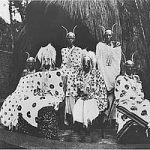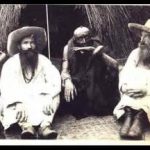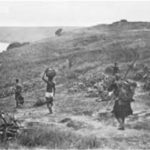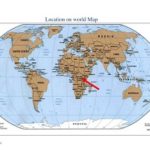The Hutu Uprising Of November 1959
The first blows of the revolution were struck in November 1959 in the vicinity of Kabgayi, Mission (Marangara and Ndiza chiefdoms). The igniting spark occurred on Sunday, November 1, when a gang of Tuutsi youths attacked the Hutu subchief Dominique Mbonyumutwa. Although he escaped with his life, rumors spread that he had been killed. Local Hutu moved quickly to retaliate. On Monday November 2, Hutu gathered for a protest outside the house of the Ndiza chief, Gashagaza; they attacked four Tuutsi notables who had sought refuge in the chief’s house, but spared Gashagaza. Among those attacked was the subchief Nkusi, who had on two previous occasions publicly threatened retribution against supporters of the Hutu parties.
Hutu in Marangara and the neighboring Ndiza chiefdom thus spearheaded the violent protests which set Rwanda on the path of revolution. Violent incidents spread from Ndiza and Marangara to other areas of Gitarama territory, then on November 6 to Ruhengeri and Gisenyi territories in the northwest. By November 7, the rural violence had reached Byumba (northeast Rwanda) and Kibuye (west-central Rwanda). On Sunday November 8 and Monday November 9, the raids extended into Nyanza and Kigali territories (where Tuutsi influence was predominant). Only three districts did not experience widespread Hutu attacks aignist Tuutsi during the November uprising. Astrida (seat of APROSOMA), Cyangugu and Kibungo.
The violence spread first in theareas of strong PARMEHUTU influence (Gitarama, Ruhengeri, Gisenyi, Byumba Territories). Similar tactics were used by Hutu in these different areas, but even so most analysts of these events consider the violence to have been spontaneous. The rapidity with which this protest spread gave evidence of intense resentments against Tuutsi rule and a desire for change among many rural people. It was directed primarily against Tuutsi chiefs, and not (at least at this stage) against the umwami. Many of those participating in the raids claimed they thought that European authorities and theumwarni had ordered destruction of Tuutsi homes. The violence was limited mainly to the burning and looting of Tuutsi dwellings while, on the whole, Tuutsi lives were spared:
Incendiaries would set off in bands of some ten persons. Armed with matches and paraffin, which the indigenous inhabitants used in large quantities for their lamps, they pillaged the Tuutsi houses they passed on their way and set fire to them. On their way they would enlist other incendiaries to follow in the procession while the first recruits, too exhausted to continue, would give up and return home. Thus day after day, fires spread from hill to hill.
Generally speaking the incendiaries, who were often unarmed, did not attack the inhabitants of the huts and were content with pillaging and setting fire to them. The most serious incidents involving tragic wounding and death occurred when the Tuutsi were determined to fight back, or when there were clashes with the forces of order.
The Hutu uprising of November 1959 was important because it demonstrated the depth of rural discontent with Tuutsi domination, and the ability of Hutu to destabilize the state. The Hutu protests also provoked a Tuutsi counterattack, better organized and more brutal than the Hutu initiatives, which forced the Belgian administration to act. As Reyntjens has pointed out, the Hutu Revolution was directed not against the Belgian administration, which claimed a monopoly of coercive force, but against the Tuutsi, who did not control the main instruments of coercion available to the state.
In its campaign appeals the UNAR party consistently called for rapid moves toward independence from Belgium. The UNAR position was based on the realization that Hutu needed time to organize and mobilize their political resources, but that once this mobilization was achieved, the political tide would be running strongly against Tuutsi powerholders. The longer the Belgians remained in the country, the
greater the chance that the Hutu protest movenaent would succeed in
dislodging the Tuutsi from power. Thus, to the extent that the European administration was not entirely neutral (and from November 1959 it decidedly was not), the continued presence of Belgian rule in Rwanda tended to aid the Hutu. In this context, the intensity of Tuutsi efforts to seize independent control of the state apparatus without delay is understandable. Yet it was these efforts which, in turn, generated strong counter-action on the part of Hutu leaders and the Belgian administration.
On Friday November 6 the umwami requested permission to reestablish order with its own army. The Belgian administration denied his request, but he ignored the order. The Tuutsi reaction began, with orders from the court to arrest certain Hutu leaders and bring them before the king. Beginning on Saturday November 7, units of the earlier Tuutsi army organization were dispatched, and a number of Hutu leaders were killed. Gitera, a prime target, was protected by Belgian-led forces; Kayibanda went into hiding. Captured Hutu were taken to the Ibwami at Nyanza, where many were then tortured by UNAR leaders.
The Tuutsi regime intended to eliminate Hutu leaders in the hope that this would squelch the movement of rural radicalism and agitation in the countryside.
The Belgian administration was not caught unprepared. Several weeks before the violence erupting Governor Harroy had contacted a friend of his, Colonel B. E. M. Guy Logiest, who was at that time an officer of the Force Publique in the Congo. Harroy asked Logiest to evaluate the military forces available to the government in Rwanda and make recommendations for sending reinforcements if necessary. An initial detachment was sent to Rwanda from Bujumbura on October 24. Additional Force Publique soldiers and Belgian paratroopers, as well as Logiest himself, came to Rwanda on November 4, after the violence erupted.
Logiest’s troops tried to prevent violence and reestablish order. But once the Tuutsi counterattack began, a major concern of the Belgian military operations in Rwanda was to protect Hutu leaders. Govemor Harroy and the umwami issued a joint proclamation calling upon the population to assist in maintaining calm in the country. A state of emergency was declared (November 11), military rule was imposed throughout Rwanda (November 12), and Colonel Logiest was appointed as Special Military Resident. By November 14, relative calm had been restored; this proved, however, to be only a temporary lull. Gradually passive resistance, as well as overt opposition to the Tuutsi chiefs, spread from central and northem Rwanda to other regions.
Harroy claims that he encouraged Colonel Logiest to install structures of administration staffed by Hutu in the aftermath of the November uprising; such measures were necessary, he and Logiest believed, to ensure that Tuutsi supporters of UNAR would not regain control of the state. Whatever the role of Harroy, Logiest clearly became an active partisan aiding the Hutu. As he later explained, at the time he believed he had to choose between two possible courses of action: Either he could support the Tuutsi structures (this would mean moving rapidly toward independence for Rwanda and, in this view, would be harmful for the popular masses in the country) or he could opt for democratization. Logiest consciously chose the latter option, knowing full well that this would “require … the establishment of a republic and the abolition of Tutsi hegemony.
After the November conflicts opposition to Tuutsi in many areas was so great that the population refused to obey Tuutsi authorities. Logiest instructed local Belgian administrators to depose as many such chiefs as possible. Other Tuutsi chiefs and subchiefs fled from their posts, often seeking refuge in neighboring areas outside Rwanda. Logiest and his delegates then appointed new, interim chiefs, who were supporters of the Hutu parties (PARMEHUTU and APROSOMA) or, in some cases, of the progressive Tuutsi party, RADER. The results of this policy were dramatic: By the beginning of March 1960, Hutu interim authorities already headed 22 of Rwanda’s 45 chiefdoms, and 297 of the 531 sub-chiefdoms. Logiest’s policy was intended to prevent a return to power by Tuutsi. It gave Hutu leaders access to valuable political resources, and put them in a favorable position to campaign for the important Commune elections scheduled for June-July 1960.
The Rwandan Revolution was thus launched in November 1959, with the Hutu uprising and the Tuutsi counterattack. The Revolution ended 22 months later, when legislative elections and a referendum on the monarchy were held in September 1961. Sporadic violent incidents punctuated this period of transition, becoming particularly severe in the weeks before the commune elections of 196o and the legislative elections of 1961. In the 1961 legislative elections, supervised by the United Nations, Hutu parties won an overwhelming majority of the votes. A referendum held at the same time resulted in a decisive rejection of the monarchy. Nine months later Rwanda regained formal independence from European rule, on July I, 1962. It is beyond the scope
of this study to analyze the intricate negotiations that occurred during this period between Belgian authorities, Hutu leaders, the United Nations Organization and various factions of’ tuutsi groups. The events of the Rwandan Revolution have been covered in detail by other authors such as Lemarchand, Murego, Linden, Reyntjens, and Harroy. Therefore I will limit my discussion of this period to one major rallestone in the Hutu struggle to gain control of the state: the commune elections held in June–July i 960, nine months after the Revolution began.
https://uk.amateka.net/the-hutu-uprising-of-november-1959/https://uk.amateka.net/wp-content/uploads/2020/09/leadersbahutu.jpghttps://uk.amateka.net/wp-content/uploads/2020/09/leadersbahutu-150x150.jpgModel CitizenshipThe first blows of the revolution were struck in November 1959 in the vicinity of Kabgayi, Mission (Marangara and Ndiza chiefdoms). The igniting spark occurred on Sunday, November 1, when a gang of Tuutsi youths attacked the Hutu subchief Dominique Mbonyumutwa. Although he escaped with his life, rumors spread...BarataBarata rpierre@ikaze.netAdministratorAMATEKA | HISTORY OF RWANDA




